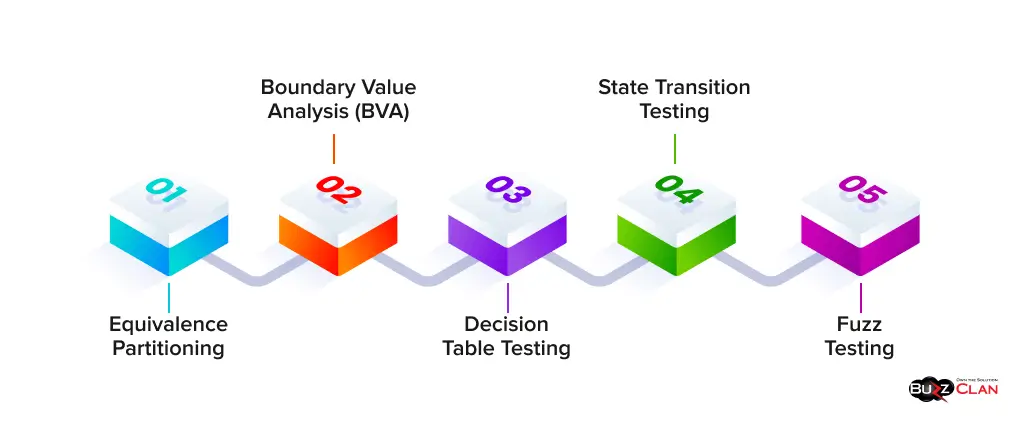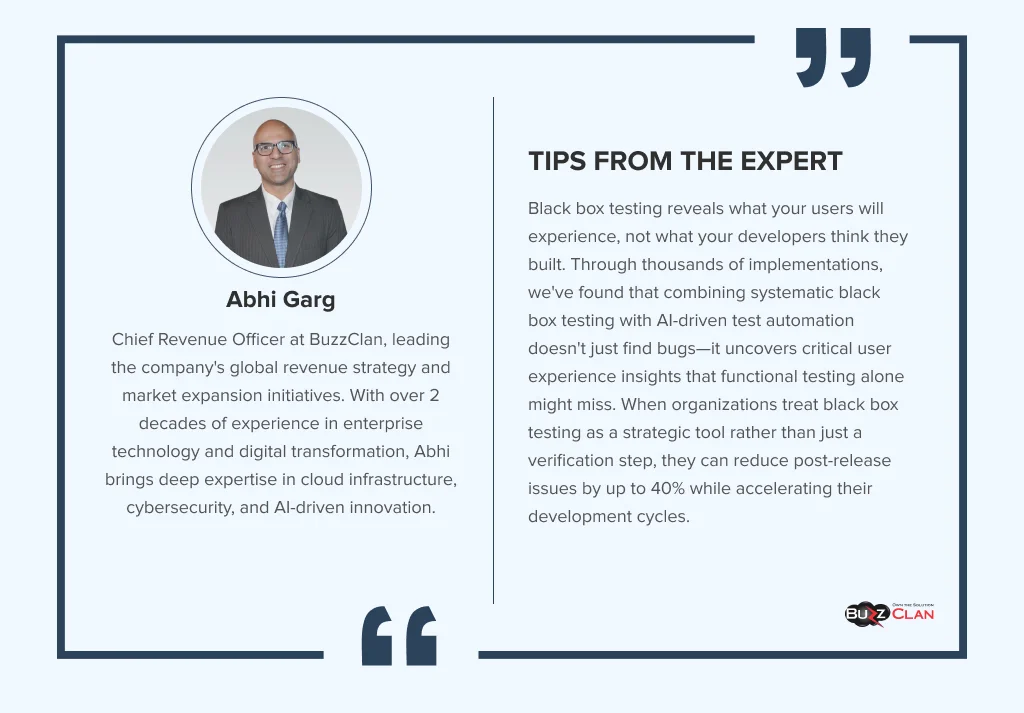The Evolution of Black Box Testing: 2025 and Beyond
Umang Chauhan
Apr 2, 2025
What is Black Box Testing?
Black box testing is integral to quality assurance software testing, also known as specification-based testing. It helps test an application’s basic to advanced functionalities without caring for or knowing its internal parts. It doesn’t understand how the software works and how its coding is done or the software’s internal knowledge or implementation details.
However, it evaluates how the software reacts to the inputs and whether or not it provides the expected outcomes to the testers, just as the end-users would test it. It also evaluates all relevant subsystems, including UI/UX, web server or application server, database, dependencies, and integrated systems.
Advantages and Disadvantages of Black Box Testing
There are several ups and downs of black box testing; let’s examine them one by one:
Advantages
Let’s analyze the benefits of black box testing, which the organization and the developers can take advantage of:
- No prior knowledge of coding or IT skills.
- The quality assurance testers do not need to learn about the software’s internal or implementation details.
- It is less expensive than other testing methods and can be outsourced.
- It can also be done on automation, making it easy and more effective with machinery power and advanced technologies.
- More straightforward setup, requiring less complex test environments.
- There is a low chance of false positives.
- The test cases in black box testing are easily reproducible and can be recorded for future convenience.
- Following the principles of quality management systems (QMS), black box testing tests the test cases by being the end-user, emphasizing customer satisfaction.
Disadvantages
Let’s analyze what challenges or limitations testers can face while doing a black box test:
- It requires prioritization, making it difficult to test every user path.
- Calculating test coverage in black box testing is usually considered complex.
- Since there is no information about how the inner parts of the software/application work, if a test fails, determining its root cause requires immense effort.
- It does not reveal the errors that have occurred in the test process in the control structure.
- The possibility of repeating the same test cases again and again increases while implementing the testing process.
Types of Black Box Testing
Black box testing can be applied to every level of software testing methodologies, such as unit, integration, and acceptance testing. It has three main types; let’s learn what those are and how they differentiate from each other:
Functional Testing
Like black-box tests, functional testing does not look into the software/application; it just ensures that the functionalities are working correctly, just as the requirements and specifications. For example, to do functional testing on a toy, you will check whether it works as it should. It fails the functional testing if it’s not working as it should. However, if the application’s functions are working correctly as written in the manual or the specifications, it’s a successful functional test. This testing focuses on checking the UI, APIs, database, security, client or server application, and functionality of the Application Under Test. The unique thing is that it can be done both automatically and manually.
Regression Testing
When a tester tests software or an application after several changes in its coding, updates to its functionalities, or new features are added, regression testing is used to determine whether the old functions or the new functionalities do not have new errors because of the changes/updates. Regression testing is a paramount part of web application testing. It also checks that the software functionalities work correctly after the changes and that the latest changes are effectively implemented.
Non-Functional Testing
Non-functional testing is a crucial aspect of software testing that evaluates a software application’s quality attributes beyond its core functionalities. It ensures the software works as intended and performs well under various conditions, providing a satisfactory user experience.
Black Box Testing Techniques

Black box testing is automated and manual, using various techniques, including equivalence partitioning, boundary value analysis, and more. Let’s learn more about each of them in detail:
Equivalence Partitioning
Equivalence partitioning produces valid and invalid partitions that minimize test cases but maintain complete coverage. Age field testing requires partitioning its inputs between valid (18-65) values and invalid cases below 18 and above 65. This method allows testers to choose important input values over an extensive evaluation of the whole input collection.
Boundary Value Analysis (BVA)
Boundary value analysis performs a variation of equivalence partitioning by testing the input parameters located at their maximum or minimum points because such locations present the highest risk potential for errors. Testing the values representing minimum and maximum limits enables testers to detect problems that typically emerge during input edge situations.
Decision Table Testing
The method employs a matrix format that shows input combinations alongside their resulting system outputs, making it optimal for intricate business operations. Decision table testing produces visible outlines of diverse condition relationships so testers can detect all potential scenarios during complete testing.
State Transition Testing
During state transition testing, the software logic is studied for its response when receiving particular inputs while shifting through various states. This method proves essential to test applications that include multiple operating states and modes, such as interfaces and process management systems. The mapping of state transitions allows representatives to examine how the software reacts correctly to different events and conditions.
Fuzz Testing
Operators of fuzzy testing systems perform the process by feeding unpredictable and random data entry into applications to locate system bugs. This technique benefits security tests enormously because it reveals malicious user attack vectors. Testing with unpredictable user interactions improves the software’s total reliability through fuzzy testing methods.
Black Box Testing vs. White Box Testing vs. Grey Box Testing
Just not the shades, but white, grey, and black box testing are different in many aspects. Let’s get a deep insight into their functionalities, definition, how they work, and much more below:
| Feature | Black Box Testing (The Outsider) | White Box Testing (The Insider) | Grey Box Testing (The Hybrid) |
|---|---|---|---|
| Knowledge Base | Zero internal knowledge. Treats the software like a mystery box. | Complete knowledge of internal code, architecture, and implementation. | Partial understanding of internal structures and algorithms. |
| Focus | Functionality, user experience, input/output validation. "Does it work?" | Internal structure, code paths, logic, and conditions. "How does it work?" | Both functionality and internal design. "Does it work efficiently?" |
| Methodology | Tests based on requirements and specifications. e.g., Equivalence Partitioning, Boundary Value Analysis. | Tests based on code structure. e.g., Statement Coverage, Branch Coverage, Path Coverage. | Tests leverage both requirements and some understanding of the codebase. |
| Who Does It? | Testers, QA engineers, and sometimes even end-users! | Developers and software engineers with deep code understanding. | Testers with development knowledge or developers with testing skills. |
| Jargon Alert! | Functional Testing, End-to-End Testing, UI Testing | Structural Testing, Code Coverage, Path Analysis | Integration Testing, Data Flow Analysis |
| Cool Factor | Mimics real-world user scenarios = great for finding usability issues. | Catches hidden bugs deep within the code; improves code efficiency. | Bridges the gap, offering a balanced approach to testing. |
Black Box Testing Process
Black box testing comes with a broadly defined testing process. Here’s how it works:

Requirement Analysis
By its name, it suggests that before performing black box testing, a tester must know and gather information regarding the application’s requirements and specifications to understand its intended purpose.
Test Planning
Creating a plan before something helps determine what we expect, how many resources, and what time. Similarly, a testing plan is developed by stating the testing goals, listing resources, and establishing deadlines and time for the test. It also involves writing down the scope, objectives, and testing strategies conducted during the test cases.
Test Case Design
Develop test cases based on the requirements. This includes defining valid and invalid inputs, expected results, and testing various scenarios using techniques such as:
- Equivalence Partitioning
- Boundary Value Analysis
- Decision Table Testing
- State Transition Testing
Test Execution
Then, the moment of truth comes, test execution. The test cases are tested to improve software quality management. The expected results match the actual results, and if there are any discrepancies, the review is appropriately documented for further processing.
Result Analysis
Analyze the results that came after the tests were executed. Record the results in an adequately documented form, along with the complete steps and detailed description for reproducing the test cases whose outcomes don’t match the expected results.
Regression Testing
Run regression testing by following the documentation and making necessary changes and updates to the application or software. Regression testing will effectively analyze that the updates remain intact, and so will the old components and functionalities of the application after the changes are made. It checks the impact of the changes and whether they are working correctly or not.
How Black Box Testing Enhances Software Quality
Black box testing is a type of penetration testing. Like penetration testing, which improves software quality, black box testing follows the same path by testing the software as an end-user would. By testing the software early in the software development lifecycle, black box testing reduces development costs and time to market. It also checks potential issues by checking the software’s usability, functionality, and reliability. Eradicating these potential issues or vulnerabilities enhances software quality.
Tools and Frameworks Used To Perform Black Box Testing
Black box testing isn’t done without any tool or framework; it is a full-fledged process performed using written procedures. Here is the list of the tools and frameworks used to perform black box testing:
| Tool/Framework | Description | Use Case |
|---|---|---|
| Selenium | Automates web browsers across multiple platforms and programming languages. | Web application testing, cross-browser compatibility testing. |
| Appium | Automates mobile applications (iOS and Android), supporting native, hybrid, and mobile web apps. | Mobile app testing, ensuring functionality and performance on different mobile platforms. |
| Cypress | The end-to-end testing framework is known for its fast and reliable test execution. | Modern web application testing, ensuring a seamless user experience. |
| JUnit | Framework for Java applications, offering annotations and integration with build tools. | Unit testing in Java, ensuring individual components work correctly. |
| Postman | API testing tool with a user-friendly interface for easy creation and automation of API tests. | API testing, verifying API endpoints, and data handling. |
| SoapUI | A comprehensive tool for SOAP and REST web service testing, supporting functional, performance, and security testing. | Web service testing, ensuring the reliability and security of web services. |
| JMeter | Performance and load-testing tool that simulates heavy loads on servers and networks. | Performance testing, identifying bottlenecks, and ensuring system stability under load. |
Cloud-Based Black Box Testing
When applications and services live in the cloud, testers leverage cloud-based black box testing to ensure their quality. This testing provides the same advantages as usual black box tests but with some extra benefits. It helps determine how well the application handles load and scaling and its reliability when operating in cloud infrastructure. It also tests and checks how the apps work under different cloud environments and configurations, testing how they function when integrated with several other cloud services.
It checks several parts, such as:
- API endpoints & interfaces
- User Interfaces
Testers evaluate how well the applications and their components, as listed above, behave when integrated with different cloud services. One significant advantage of cloud-based black box testing is that it checks the cloud applications’ input and output without caring about internal processes and informational details, providing an unbiased evaluation of the app’s functionality.
Performance and Load Testing in Black Box Methodologies
As the name suggests, performance and load testing checks how the application works when high-performance tasks are conducted or when a large user base tries to access and run the app. It evaluates several measures, such as an app’s speed, stability, reliability, and responsiveness under various conditions. Let’s take the example of a car and understand how performance and load testing in black box methodologies work.
Suppose a car (software/application) and a driver (tester) exist. First, the app’s performance under normal conditions is evaluated. How fast is it? What is the download and upload speed? After assessing these aspects, a standard and fundamental starting point is noted.
After this, load testing comes into play. Now, the car is given an excessive load on its performance by adding weight and testing its performance. Adding weight gives the application a load of users to test how it manages demand. This evaluates how the app would work when many users surf it.
To take things further, stress testing is performed. Stress testing means pushing the application to its limit to analyze its tolerance, knowing its breaking point. This testing helps to see how the application behaves in extreme scenarios. Throughout all this testing, they keep track of essential measurements like:
- How quickly the application responds
- How many errors occur
- How much computer power it’s using
- How much memory does it need
These testing methodologies (an inherent part of total quality management) use a black box approach, so they cannot tell what is wrong inside the application; they can only explain the errors by observing the output after the testers give the input.
When Shouldn’t You Use Black-Box Testing?
Black box testing isn’t a form that can be used anywhere. It has times when a business or a tester shouldn’t use black box testing; let’s understand what those are:
Complex Systems
Black box testing is not the best method for applications or software with complex systems or internal coding and elements. Because this type of testing does not examine the internal parts, it is ineffective in identifying system issues or faults. It often overlooks problems related to memory management, concurrency, or data consistency.
Security Testing
Black box testing isn’t suitable for testing the application’s security vulnerabilities. Since there is no knowledge of the internal elements, testers cannot check the inner coding where security loopholes or flaws exist.
Performance Testing
Black box testing is generally ineffective for performance evaluations, as it cannot assess algorithm efficiency or resource utilization. The system is nonfunctional for several requirements, such as response time and load handling. Black box methods cannot fulfill these requirements as they do not provide more in-depth analysis.
Limited Documentation
If the documentation is not top-notch/complete, i.e., listing the application’s specifications, there can be several incompetencies while making the test scenarios. The designing of compelling test cases becomes challenging.
Debugging Challenges
Since black box testing does not tell the tester which code lines are right or wrong, finding the wrong line becomes challenging when identifying and fixing bugs, which is a priority. This results in debugging challenges.

Future Trends in Black-Box Testing
With advanced technologies such as machine learning, deep learning, and AI in quality assurance, several future trends in black box testing will soon be seen. Here are some of them:
Automation Integration
Today, organizations widely adopt automated testing tools to operate. Automated processing of tests enables the smooth execution of test cases through multiple scenarios without workforce participation. Such a development improves black box testing capabilities by speeding up the process while making it more dependable so testers can concentrate on complex software evaluation tasks.
AI and Machine Learning Impact
Implementing artificial intelligence (AI) alongside machine learning (ML) methodologies will completely transform black-box testing operations. These technologies provide features for digital assessment, such as user behavioral patterns, predictive analytics, and test case optimization. AI tools and software improve the detection power for anomalies through data-driven behavior simulation models that enhance testing precision.
Continuous Testing in DevOps
Continuous testing will be a standard practice in the development lifecycle of DevOps implementations. Black box testing will be integrated into continuous integration/continuous deployment pipelines to conduct comprehensive and standardized code testing before each deployment. This method facilitates the speed of feedback communication, improving software deployment quality.
Enhanced User Experience Focus
In future trends, black box testing will receive increased focus by becoming directly integrated with UI/UX design principles. Test engineers will advance by creating real-world environment simulations to verify applications fulfill user needs regarding functionality while guaranteeing usability.
Advanced Testing Techniques
Fuzzy testing and error guessing will become increasingly popular as advanced techniques in black box methodologies. Applications subjected to fuzzy testing methods will detect security vulnerabilities through tests with interruptive data inputs, thus producing superior protection evaluation results.
Cross-Platform Testing
Black box testing will extend its scope to achieve uniform results when testing multi-platform applications across multiple devices with diverse operating systems and browsers. Because of this emerging trend, complete test strategies must include features for different user environments.
How BuzzClan Can Implement Modern Black Box Testing Strategies
BuzzClan delivers expert, tailored black box testing solutions focusing on user experience and functionality. We boost your software quality by:
- Creating custom strategies targeting high-risk areas.
- Using AI-powered automation for faster releases.
- Seamlessly integrating with Agile and DevOps workflows.
- Offering flexible, cloud-based testing environments.
Partner with BuzzClan today to ensure your applications are exceptional!
Conclusion
Ultimately, if you want to test your software or applications as how your end-users or customers will do, without getting into the coding knowledge, go with black-box testing. Because of its advantages, testers can launch the testing process by considering its challenges and implementing best practices for checking every application functionality. Moreover, if you want to go to lighter shades of testing, you can consider white or grey testing methods that differ in their knowledge base and the components they focus on.
In addition, as discussed above, black box testing can be easily outsourced; choose someone who can deliver cutting-edge solutions with robust customer support. BuzzClan, with its 13+ years of IT service-providing experience, uses AI-powered automation, cloud-based testing environments, and custom strategies to offer tailored black box testing solutions.
FAQs

Get In Touch
